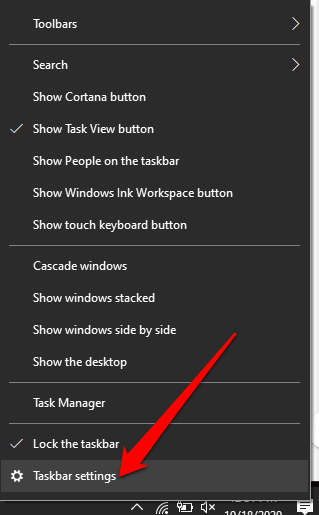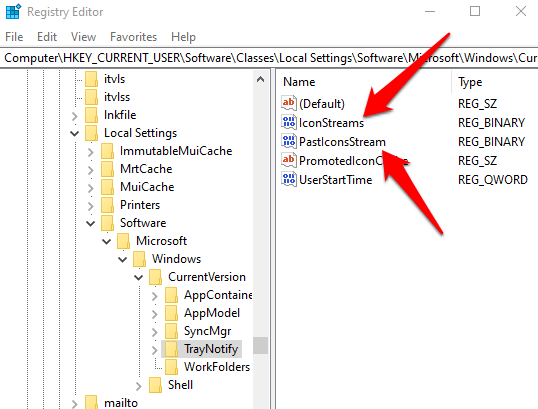- in Windows 10 by Admin
How to Fix System Tray or Icons Missing in Windows 10
The Windows 10 System Tray (Notification area), is located on the right side of the taskbar and provides access to system notifications, functions, and apps.
The system tray also holds shortcuts to some important settings like network, power, volume, and Action Center icons.
If you hover over the system tray and notice that the icons you use are missing, there are several reasons why this happens. You may have installed a Windows Update, which caused a glitch, or there are corrupted Registry entries that seem to conflict with Windows 10, making the system tray or icons disappear.
Here’s how you can fix the system tray or icons missing in windows 10 problem.
How to Fix System Tray or Icons Missing in Windows 10
There are two ways to show hidden icons in the system tray: Using the mouse and using Windows 10 Settings.
Use a Mouse to Show Hidden Icons in the System Tray
To do this using your mouse, select the arrow next to the Notification area to open the system tray and reveal the hidden icons. You can also drag the icons with your cursor and drop them on the taskbar.

Use Windows 10 Settings to Show Hidden Icons in the System Tray
If you want to see all your icons in the system tray all the time, remove the arrow and expandable pane, and enable the Always show all icons in the notification area setting.
- To do this, right-click your taskbar and select Taskbar Settings.

- Next, go to the Notifications area and click the Select which icons appear on the taskbar option.

- Toggle the Always show all icons in the notification area setting at the top of the list.

Note: Icons in the system tray only appear when their corresponding apps are running.
Turn System Icons On or Off
If you still don’t see icons on your system tray, use the Turn system icons on or off setting and see if it helps.
- To do this, right-click the Taskbar > Taskbar Settings.
- In the Taskbar Settings, go to the Notification area and select Turn system icons on or off.

- Find the system icons you want to show on the system tray and toggle their sliders to On (if they’re Off).

Restart your computer for the changes to take effect.
Restart Windows Explorer
Restart Windows Explorer to reload it and restore the missing system tray or icons on your computer.
- To do this, right-click the taskbar and select Task Manager.

- Select explorer.exe under the Processes tab, right-click and select End Task.
- Next, open the App History tab, click File > Run New Task.

- Type explorer.exe in the message box that appears and select OK.

Windows Explorer (explorer.exe) will reload and the icons will appear in the system tray. If there’s an icon you don’t see, go back to the Taskbar settings, select Turn system icons on or off and check the box next to the missing icon.
Reset or Delete the IconCache
The icon cache database contains the icons you see on apps and files so that the operating system can display them on your screen. Caching icons keeps your system from slowing down by not having to look up icons every time.
However, as the icon cache database grows, corruption may creep in and the icons may not render correctly, may appear broken, or missing from the system tray.
To resolve this problem, try to reset or delete the IconCache to resolve the problem.
How to Reset the IconCache Database on Windows 10
- To reset the icon cache database, close all running applications, and then open the command prompt. Type CMD in the search bar and select the Run as administrator option.

- Type this path in the command prompt window and press Enter:
cd %homepath%AppDataLocalMicrosoftWindowsExplorer

- Next, type dir iconcache* and press Enter (a list of database files will appear).

- Stop File Explorer by typing the command: taskkill /f /im explorer.exe and then press Enter. You’ll notice your taskbar and desktop background disappear after terminating File Explorer, but it’s temporary. Closing File Explorer helps delete the icon cache files.
- Next, type del iconcache* and press Enter.
- Type dir iconcache* to confirm that you have deleted the icon cache files, and then press Enter. Start File Explorer by typing explorer.exe and press Enter.
Close Command Prompt to complete the process, and Windows will recreate the database files with new icons.
How to Delete the IconCache Database on Windows 10
- To delete the IconCache database file, right-click Start > Run and enter %appdata% in the Run window to open the Roaming folder.

- In the Roaming folder, select Appdata in the address bar.

- Select the Local folder.

- Select View and check the Hidden items option.

- Right-click IconCache in the Local folder, and select Delete.

- Close Windows Explorer, reboot your PC, and check whether the system tray and icons are visible again.
Disable Controlled Folder Access
Controlled Folder Access is an intrusion prevention feature in Windows 10 that protects your valuable data from modification by threats like malware, viruses, and ransomware. If you find system tray or icons missing in Windows 10, try disabling the Control folder access option and see if they’re restored after that.
- To disable Control folder access, select Start, type Windows Security in the search box, and select Virus & Threat protection.

- Scroll down to Ransomware protection and select Manage ransomware protection.

- Next, toggle the Control folder access option button to turn it off or disable it.

Reinstall the Taskbar
If the system tray or icons are missing on your computer, chances are the taskbar may not be working properly. To resolve this, reinstall the taskbar using Windows PowerShell.
Right-click Start > Windows PowerShell (Admin).

Copy and paste this command and press Enter:
Get-AppxPackage -AllUsers| Foreach {Add-AppxPackage -DisableDevelopmentMode -Register “$($_.InstallLocation)AppXManifest.xml”}

Check if your system tray and icons are back in the notification area.
Edit the Registry
Editing the Windows Registry helps correct errors or corruption, or prevent undesired system activity. The process can be dangerous, especially if you make a wrong edit in the wrong entry, so make sure you backup the registry before proceeding with the steps below.
- Select Start > Run and type regedit in the Run window to open the Registry Editor.

- Next, navigate to the HKEY_CURRENT_USERSoftwareClassesLocalSettingsSoftwareMicrosoftWindowsCurrentVersionTrayNotify key.

- Select the Tray Notify folder, and then right-click IconStreams and PastIconsStream to delete their values.

If nothing else works, try a System Restore as this protects and repairs your computer’s software. It saves the Windows Registry and some system files as restore points for use in case of data corruption or an install failure.
A System Restore returns the system to working condition by reverting back the settings and files saved to the restore point.
Get Your System Tray and Icons Back
We hope these steps helped you get your missing system tray and icons back. Make sure to search the rest of our site for more troubleshooting tips and tricks to help you fix other issues in different operating systems and devices.